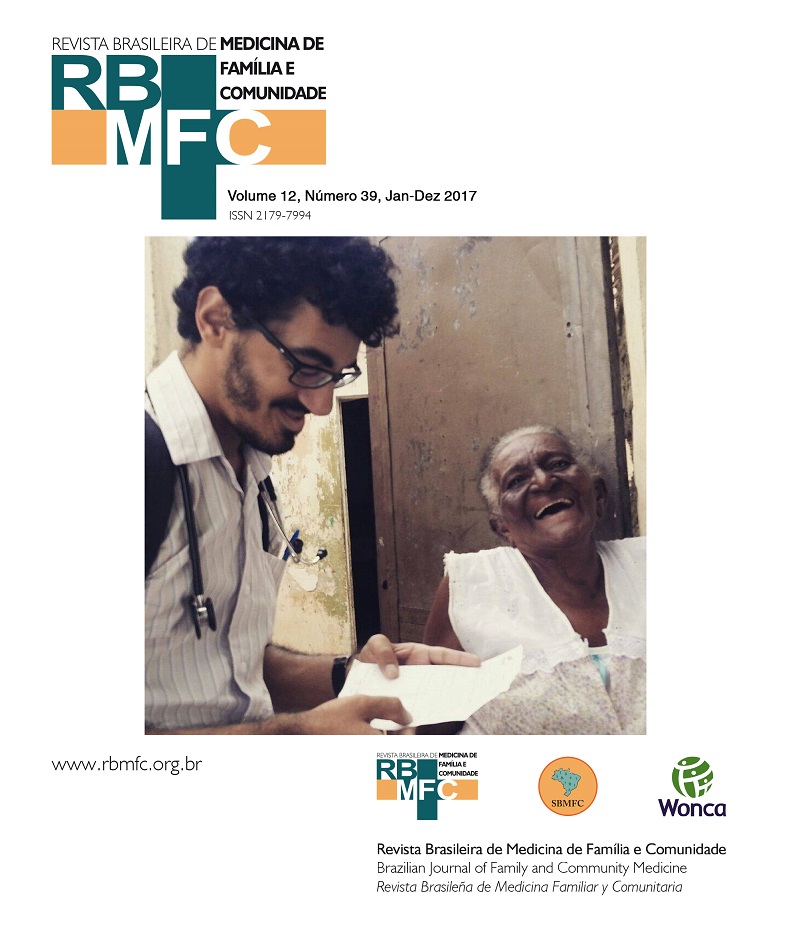Asymptomatic hyperuricemia - to treat or not to treat? - An evidence based review
DOI:
https://doi.org/10.5712/rbmfc12(39)1396Keywords:
Hyperuricemia. Asymptomatic Condition. Uric Acid. Primary Health CareAbstract
Introduction: Assessment of serum uric acid is frequently done in Primary Health Care, although not scientifically recommended. The subsequent therapeutic approach is often a clinical challenge, particularly in the case of asymptomatic hyperuricemia (AH). The aim of this study was to review the evidence on AH treatment. Methods: A research was conducted on Medline and evidence-based medical sites for articles published between April 2012 and April 2016 in English, Spanish or Portuguese using the keywords “hyperuricemia” and “asymptomatic conditions”. Results: Five articles met the inclusion criteria: one meta-analysis (MA), three systematic reviews (SR) and one original study (OS). MA and OS recommend treatment of AH, for the prevention of renal dysfunction and for the prevention of cardiovascular events (CV), respectively. Two SR do not recommend treatment of AH and one says that pharmacological treatment should be considered after an individual assessment of risk/benefit ratio, particularly in the prevention of gout in subjects with serum uric acid above 9 mg/dL. Conclusion: Very limited scientific data are available on the pharmacologic treatment of AH, with limitations and controversial results. The clinical significance of AH and its causal relationship with occurrence of acute attacks of gout, renal dysfunction and cardiovascular disease are still uncertain. There is no scientific evidence to support the pharmacological treatment of HA in asymptomatic patients (SOR B). Further studies, that are methodologically robust and oriented to the patient are needed.
Downloads
Metrics
References
Akkineni R, Tapp S, Tosteson AN, Lee A, Miller KL, Choi HK, et al. Treatment of asymptomatic hyperuricemia and prevention of vascular disease: a decision analytic approach. J Rheumatol. 2014;41(4):739-48. DOI: http://dx.doi.org/10.3899/jrheum.121231 DOI: https://doi.org/10.3899/jrheum.121231
Zhu Y, Pandya BJ, Choi HK. Prevalence of gout and hyperuricemia in the US general population: the National Health and Nutrition Examination Survey 2007-2008. Arthritis Rheum. 2011;63(10):3136-41. DOI: http://dx.doi.org/10.1002/art.30520 DOI: https://doi.org/10.1002/art.30520
Viazzi F, Leoncini G, Pontremoli R. Cardiovascular and renal effects of hyperuricaemia and gout. Reumatismo. 2012;63(4):253-62. DOI: http://dx.doi.org/10.4081/reumatismo.2011.253 DOI: https://doi.org/10.4081/reumatismo.2011.253
Vinik O, Wechalekar MD, Falzon L, Buchbinder R, van der Heijde DM, Bombardier C. Treatment of asymptomatic hyperuricemia for the prevention of gouty arthritis, renal disease, and cardiovascular events: a systematic literature review. J Rheumatol Suppl. 2014;92:70-4. DOI: http://dx.doi.org/10.3899/jrheum.140465 DOI: https://doi.org/10.3899/jrheum.140465
Emmerson BT. The management of gout. N Engl J Med. 1996;334(7):445-51. DOI: http://dx.doi.org/10.1056/NEJM199602153340707 DOI: https://doi.org/10.1056/NEJM199602153340707
Wang H, Wei Y, Kong X, Xu D. Effects of urate-lowering therapy in hyperuricemia on slowing the progression of renal function: a meta-analysis. J Ren Nutr. 2013;23(5):389-96. DOI: http://dx.doi.org/10.1053/j.jrn.2012.08.005 DOI: https://doi.org/10.1053/j.jrn.2012.08.005
Kim SY, Guevara JP, Kim KM, Choi HK, Heitjan DF, Albert DA. Hyperuricemia and coronary heart disease: a systematic review and meta-analysis. Arthritis Care Res (Hoboken). 2010;62(2):170-80. DOI: http://dx.doi.org/10.1002/acr.20065 DOI: https://doi.org/10.1002/acr.20065
Zechman E. What to Do--or Not--About Asymptomatic Hyperuricemia. [citado 17 Jan 2017]. Disponível em: http://www.medpagetoday.com/resource-center/Gout/Asymptomatic-Hyperuricemia/a/49781
Macías N, Goicoechea M, de Vinuesa MS, Verdalles U, Luño J. Urate reduction and renal preservation: what is the evidence? Curr Rheumatol Rep. 2013;15(12):386. DOI: http://dx.doi.org/10.1007/s11926-013-0386-3 DOI: https://doi.org/10.1007/s11926-013-0386-3
Ebell MH, Siwek J, Weiss BD, Woolf SH, Susman J, Ewigman B, et al. Strength of recommendation taxonomy (SORT): a patient-centered approach to grading evidence in the medical literature. Am Fam Physician. 2004;69(3):548-56. DOI: http://dx.doi.org/10.3122/jabfm.17.1.59 DOI: https://doi.org/10.3122/jabfm.17.1.59
Graf SW, Whittle SL, Wechalekar MD, Moi JH, Barrett C, Hill CL, et al. Australian and New Zealand recommendations for the diagnosis and management of gout: integrating systematic literature review and expert opinion in the 3e Initiative. Int J Rheum Dis. 2015;18(3):341-51. DOI: http://dx.doi.org/10.1111/1756-185X.12557 DOI: https://doi.org/10.1111/1756-185X.12557
Araújo F, Cordeiro I, Teixeira F, Rovisco J, Ramiro S, Mourão AF, et al. Portuguese recommendations for the diagnosis and management of gout. Acta Reumatol Port. 2014;39(2):158-71.
Downloads
Published
How to Cite
Issue
Section
License
By submitting a manuscript to the RBMFC, authors retain ownership of the copyright in the article, and authorize RBMFC to publish that manuscript under the Creative Commons Attribution 4.0 license and identify itself as the vehicle of its original publication.















